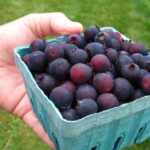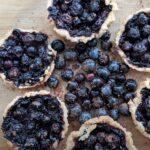As the season peaks, usually from late June to mid-July, you can find Saskatoon berries fresh off the bush. They offer versatility in the kitchen, being ideal for an array of recipes, from traditional pies to innovative sauces.
While fresh berries offer the best flavor and nutritional value, many local growers and orchards ensure a supply of frozen berries year-round. With the ability to purchase directly from orchards or through farmers’ markets, indulging in and supporting local agriculture has never been easier.
Key Takeaways
- Natural growing season, which spans from late June to mid-July.
- The ideal time for harvesting Saskatoon berries is in July.
- Superfood, packed with antioxidants, vitamins, and fiber, contributes to a healthy diet.
- Nutritional profiles make them perfect for a wide range of dishes.
Overview
Saskatoon berries are a nutrient-rich fruit known for their resemblance to blueberries and significant health benefits.
Saskatoon berries, scientifically known as Amelanchier alnifolia, grow on a deciduous shrub native to North America. They ripen in June and July, and you can find them in various forms from fresh fruit at local markets to processed products such as jams and syrups. Distinguished by their sweet, nutty flavor, Saskatoon berries have a deep purple skin and are similar in size to blueberries.
Nutritional Profile
Saskatoon berries have an impressive nutritional profile. They are rich in antioxidants, including anthocyanins, which give them their characteristic dark hue. Here’s a glance at the primary nutrients per 100 grams of Saskatoon berries:
| Nutrients | Amount |
|---|---|
| Calories | 85 kcal |
| Protein | 1.33 g |
| Fat | 0.49 g |
| Carbohydrates | 18.9 g |
| Fiber | 5.9 g |
| Sugars | 12.2 g |
| Calcium | 42 mg |
| Magnesium | 24 mg |
| Potassium | 162 mg |
| Vitamin C | 3.6 mg |
It’s easy to see why these berries are often considered a superfood given their concentration of vitamins and minerals. Including them in your diet can contribute to overall health and well-being.
Harvesting Period – Season Pick
When you’re planning to pick Saskatoon berries, timing is essential to ensure you get the best flavor and quality. Specific periods for harvesting these berries align with their peak maturity.
Best Time to Harvest
The optimal time to harvest Saskatoon berries is typically in July. You should aim to pick the berries when they display a deep blue or dark purple hue and yield slightly to the touch. They should not be hard; otherwise, they aren’t fully ripe. Berries at this stage are sweet, juicy, and tart, ideal for consumption or processing. To capture peak flavor, consider harvesting them early in the morning, especially if the weather is hot.
Harvesting Methods
- Hand-picking: This traditional method allows for selective harvesting, ensuring you only collect berries at their prime ripeness. It’s labor-intensive but gentle on the plants.
- Mechanical harvesting: Suitable for large-scale operations, this method uses machinery to shake berries from the branches. Mechanical methods may require a follow-up sorting process to remove unripe or overripe berries.
Cultivation of Saskatoon Berries
Saskatoon berries thrive in specific conditions and require proper planting techniques to flourish. Here’s what you need to know to cultivate these hardy plants successfully.
Growing Conditions
Saskatoon berries favor well-drained soil enriched with organic compost. They are versatile and adapt well to a variety of soil types, but they typically prefer soil pH to be mildly acidic to neutral. It would help if you aimed for a site with full sun to partial shade to optimize berry production. These plants can withstand cold temperatures, even as low as -60°F.
Planting Techniques
When planting Saskatoon berries, proper spacing is crucial. Plant the bushes about 2 to 3 feet apart to ensure adequate air circulation and sunlight penetration. Dig a hole twice the width of the root ball and as deep as the root ball’s height. Mix in compost with the native soil when backfilling the hole to provide the nutrients the plant will need. Regular watering after planting is essential to establish the root system.
Saskatoon Berry Uses
Saskatoon berries are versatile in their uses, whether you intend to eat them fresh, incorporated into various dishes, or preserved for future enjoyment.
Culinary Applications
Your Saskatoon berries can be a delightful addition to many recipes. Often compared in flavor and appearance to blueberries, they lend themselves well to sweets such as pies and tarts. They are excellent when eaten fresh or added to morning oatmeal or yogurt for a nutrient-rich start to your day. Their antioxidant properties make them not only a healthy but also a tasty ingredient in smoothies. For savory applications, consider tossing them into a salad or using them as a base for sauces and glazes that pair well with game or pork.
Preservation and Storage
When it comes to preserving your Saskatoon berries, there are a few methods you can rely on to extend their shelf life:
- Freezing: Wash and dry the berries thoroughly, spread them out on a baking sheet, and freeze until solid before transferring tthem o airtight containers. This helps maintain their shape and makes them easy to use in portions.
- Canning: You can make jams, jellies, and preserves with Saskatoon berries using a traditional water bath canning method.
- Drying/Dehydrating: Dehydrate the berries at a low temperature until they are completely dry, which typically keeps them edible for several months when stored in a cool, dry place.
By following these methods, you can enjoy the flavor of Saskatoon berries year-round.
Availability and Purchase
Saskatoon berries, known for their sweet and nutty flavor, have a brief but bountiful season. You can find fresh berries typically from late June to mid-July, ensuring you get them at their peak.
Where to Buy
U-Pick Farms: Many farms offer a U-Pick experience, allowing you to harvest Saskatoon berries yourself. For instance, Solstice Berry Farm has U-Pick for their berries without reservations or fees. Ensure to plan your visit within the 3-4 week picking window.
Farmers Markets: During the season, Saskatoon berries are commonly available at local ffarmers’markets. Look for vendors that specialize in local and fresh produce.
Specialty Food Stores: Some stores stock fresh Saskatoon berries in season, or have frozen options available year-round.
Choosing Quality Berries
Appearance: Search for plump, unblemished Saskatoon berries with a deep purple-blue hue. Avoid any that are overripe or mushy.
Texture and Flavor: Fresh Saskatoon berries should be firm to the touch. While it’s challenging to taste berries before purchasing, you can often find tasting stations at U-Pick farms or markets.
Supporting Local Growers
When you choose to support local Saskatoon berry growers, you’re directly contributing to your community’s economy and ensuring the survival of local agriculture. Let’s explore how you can make a difference.
Community Supported Agriculture
Community Supported Agriculture (CSA) programs allow you to subscribe to the harvest of a specific farm. By joining a CSA that includes Saskatoon berries, you get fresh berries at peak season and help stabilize the farm’s income.
Farmers Markets
Your local farmers market is a hub for discovering locally grown Saskatoon berries. Remember, purchasing from farmers markets also tends to keep a larger share of revenue within your local economy.
Frequently Asked Questions
When is the peak season for harvesting Saskatoon berries?
The peak season for harvesting Saskatoon berries generally falls in late June to July. The timing may vary slightly depending on the local climate and weather conditions.
What distinguishes Saskatoon berries from blueberries?
While they may look similar, Saskatoon berries differ from blueberries in flavor and texture. Saskatoons have a sweeter, nuttier taste and are less juicy with firmer flesh. Their nutritional profiles also vary, with Saskatoons being rich in fiber, vitamins, and antioxidants.
Are Saskatoon berries available for purchase in the United States?
Yes, you can find Saskatoon berries in the United States, especially in the Northwestern and North-central regions, where they are native. They may not be as commonly found as other berries, but specialty stores and farmers’ markets are good places to look.
What alternative names do Americans use for Saskatoon berries?
In America, Saskatoon berries are also known as juneberries, serviceberries, or shadbush berries.
Is it safe to consume raw Saskatoon berries?
AYoucan safely consume raw Saskatoon berries. They are delicious eaten fresh and are also used in various recipes like pies, jams, and salads.
What are the natural growing conditions for Saskatoon berries?
Saskatoon berries thrive in well-drained, sandy loam soils and benefit from full sun exposure. They are hardy plants, withstanding cold temperatures and growing natively across the Canadian prairies, among other regions.
Conclusion
Saskatoon berries offer a delightful blend of flavor and nutrition, making them a valuable addition to your diet. With their peak season in July, supporting local growers ensures access to these delicious berries year-round. Whether you enjoy them fresh, in recipes, or preserved, Saskatoon berries are a versatile and healthful choice.






